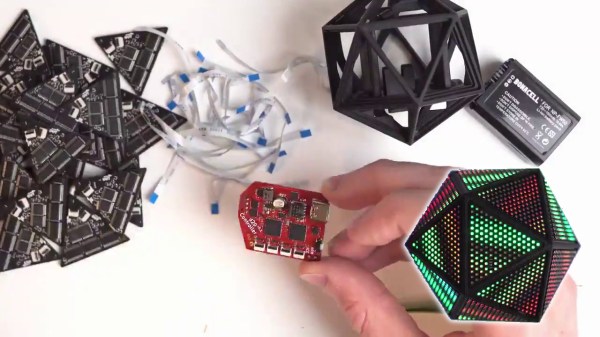The D20, or twenty-sided die, is most commonly known in the shape of a regular icosahedron. It’s a fantastic, enchanting geometry, and one that has held the balance of fate in innumerable tabletop roleplaying games over the years. It was this sacred geometry that [Greg Davill] chose to bless with the glory of glowing RGB LEDs. Now, [Greg] has shared the files so you can build your own.
 The development blog of the D20 is a great read, highlighting the challenges of creating such a compact item that glows so brilliantly. The design uses a full 2400 1.5 mm x 1.5mm LEDs, in the old-school RGB style, split evenly between the twenty sides. That’s right, there’s no fancy self-addressing smart LEDs here — each LED is manually controlled directly by [Greg]’s hardware. A SAMD51 and ICE40UP5K FPGA are put to work running the displays. Each panel is held together in a barely-there 3D printed frame, linked together with ribbon cables to keep things compact. A Sony camera battery is slotted inside the tight confines of the frame to supply the necessary power.
The development blog of the D20 is a great read, highlighting the challenges of creating such a compact item that glows so brilliantly. The design uses a full 2400 1.5 mm x 1.5mm LEDs, in the old-school RGB style, split evenly between the twenty sides. That’s right, there’s no fancy self-addressing smart LEDs here — each LED is manually controlled directly by [Greg]’s hardware. A SAMD51 and ICE40UP5K FPGA are put to work running the displays. Each panel is held together in a barely-there 3D printed frame, linked together with ribbon cables to keep things compact. A Sony camera battery is slotted inside the tight confines of the frame to supply the necessary power.
We first covered the project late last year, and it’s great to see it out there now in a form that’s readily reproduced. Assembly of such a board is not for the faint of heart, however, with plenty of fine SMD parts to tangle with. We suspect this is just yet another salvo in the ongoing arms race of LED glowables, and we can’t wait to see what [Greg] — and the rest of the community — comes out with next. If you’ve got a lead on the new glowing hotness, let us know. Video after the break.
Continue reading “You Can Now Build Your Own Glowing LED D20 (with A Whopping 2,400 LEDs)”






 [Vejdemo-Johansson] figured a circle of 4 tilt sensors mounted on the one and twenty face would be enough to detect critical rolls. If any of the switches were tilted beyond 30 degrees, the switch would close. He mounted eight ball-tilt switches and glued in the LEDs. A hackerspace friend also helped him put together an astable multivibrator to generate the pulses for non-critical rolls.
[Vejdemo-Johansson] figured a circle of 4 tilt sensors mounted on the one and twenty face would be enough to detect critical rolls. If any of the switches were tilted beyond 30 degrees, the switch would close. He mounted eight ball-tilt switches and glued in the LEDs. A hackerspace friend also helped him put together an astable multivibrator to generate the pulses for non-critical rolls.








